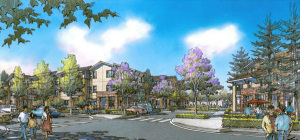Spotswood gets it wrong on planning
MEHC is Perplexed with Spotswood’s take on Planning
The Marin Environmental Housing Collaborative – MEHC – is a partnership of affordable housing, environmental, and social justice advocates. We are responding to Dick Spotswood’s May 4 article in which he takes on the “push” by the Association of Bay Area Governments and the Metropolitan Transportation Commission to “partially urbanize” eastern Marin.
Dick says that the initiative for multi-unit housing emanates from California laws that require regional agencies plan for projected huge population growth, but he feels that the reality of this growth is dubious. He goes on to claim that the environmental rationale for the regional agencies’ planning is wrong, and is actually a fig leaf to promote “new urbanism” and high-density development. We have studied Dick’s arguments, and we are perplexed.
Dick claims that the regional agencies’ theoretical inducement is that by building multi-unit housing near transit, greenhouse gas emissions will be reduced, but that the theory is wrong. We have never heard of this theory. But then, Dick gets it right when he says “transit-centered development will generate fewer greenhouse gases than if the same development occurred not adjacent to transit. That’s obvious.” We agree with Dick on this point; it’s a fact, not a theory.
Strangely however, after acknowledging that multi-unit housing near transit generates less green house gas than other housing types, Dick goes on to say that if no housing is built, there will be no additional greenhouse gases. This takes us back to population growth, which Dick also questions.
Last year, driven by economic development in Silicon Valley, the Bay Area was the fastest growing region in California. Over the long-term, regional growth will continue. Here in Marin, vacancies in commercial buildings are filling up, San Rafael is getting ready to approve more office space downtown, and Novato is actively courting bio-medical firms to support economic development. Regional and local job growth demands more housing. Marin’s failure to build housing affordable to the local workforce already compels 60% of the people employed here to commute from out of county. It also inhibits diversity and social equity, qualities that are essential for vibrant, healthy communities.
Dick is mistaken in his assertion that if higher density transit-oriented homes are not built here to house local workers, there will be no additional greenhouses gases. Quite the opposite: The homes that could be in transit-oriented development that aren’t built here will be built elsewhere, resulting in longer commutes and more greenhouse gas emissions.
Marin can’t completely solve our jobs/housing imbalance and the extra-large carbon footprint that results from it, but we can do better. The Marinwood Village project is a good example of what we must do. Bridge Housing has applied to the county to redevelop the blighted Marinwood Plaza shopping center with 7,600 square feet of new commercial space, 72 affordable apartments and 10 market rate units on 5.17 acres. The project is in easy walking distance of the Golden Gate bus stop on Highway 101. BRIDGE has an excellent track record of successful, well managed projects. This small in-fill project will provide workforce housing close to transit. MEHC is actively supporting Marinwood Village as an example of the transit-oriented development that Dick Spotswood acknowledges will slow the growth of greenhouse gas emissions.
Colin Russell, Architect
Board Member, MEHC

